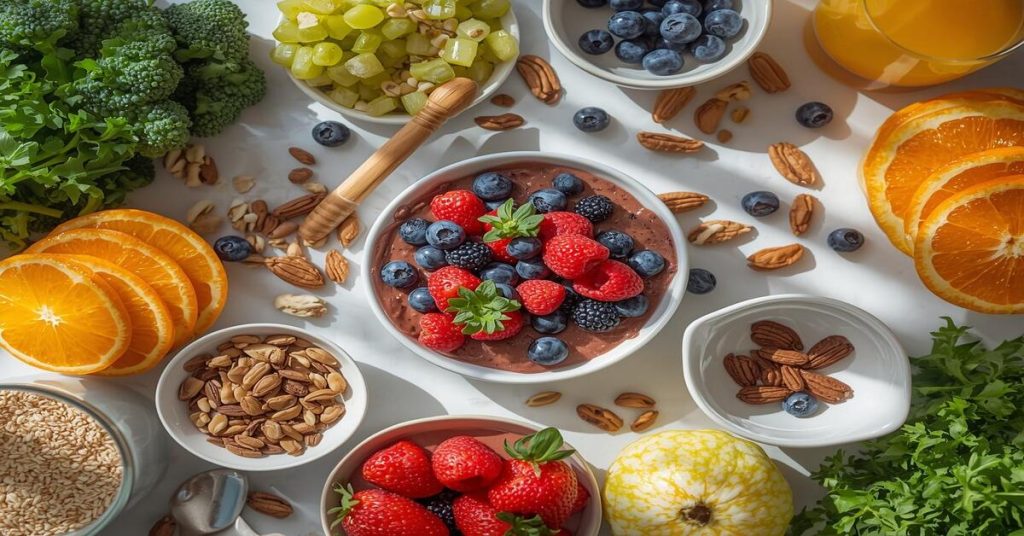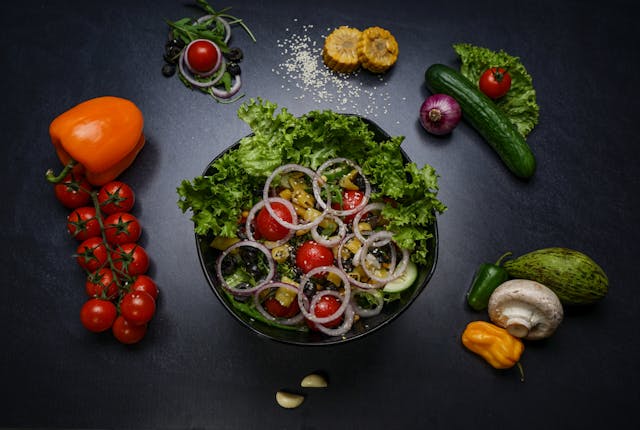⏰ Chrononutrition for Energy: 20 Proven Meal-Timing Strategies

Are you eating all the “right” foods but still feeling tired? The missing link might be *when* you eat. Chrononutrition for energy uses your body’s internal clock—also known as circadian rhythm—to help optimize metabolism, hormone release, and energy levels.
🔍 What Is Chrononutrition?
Chrononutrition is the science of aligning your meals with your body’s natural rhythms. Eating at the right times can enhance nutrient use, improve sleep, and boost day-long vitality. Research shows that meal timing influences metabolic health and energy efficiency 4.
Read more: Complete Guide to Healthy Eating and Nutrition for a Better Life 🍎
🔢 20 Proven Chrononutrition for Energy Strategies
-
- Front‑load your calories: Eat your largest meal in the morning or early afternoon. This aligns with your body’s highest insulin sensitivity and digestive capacity, helping to stabilize blood sugar and avoid late-day fatigue.
- Time your protein intake: Prioritize protein sources like eggs, Greek yogurt, or legumes at breakfast and lunch. This promotes muscle repair and satiety while reducing mid-day cravings and energy crashes.
- Save carbs for energy windows: Consume complex carbs like oats or quinoa in the morning or post-workout when your body uses them efficiently. Avoid refined carbs in the evening to prevent sluggishness.
- Include light snacks: Healthy snacks like nuts, fruits, or hummus help maintain steady glucose levels between meals. This keeps your mind alert and prevents the energy rollercoaster.
- Set a caffeine cut-off: Limit caffeine to before noon to avoid disrupting your circadian rhythm. Afternoon caffeine may interfere with melatonin production and reduce sleep quality, which affects next-day energy.
- Avoid late-night eating: Eating close to bedtime can trigger insulin spikes and interfere with restorative sleep. Finish your dinner at least 3 hours before sleep to allow proper digestion.
- Consistent meal schedule: Regular eating times reinforce your internal clock, optimizing digestive enzyme release and hormone balance. Irregular timing can confuse your metabolism and lead to energy dips.
- Hydrate strategically: Start your day with a glass of water and continue hydrating before meals. Dehydration, even mild, can lead to fatigue and reduced focus throughout the day.
- Use time-restricted eating: Adopt an 8–10 hour eating window that fits your schedule, like 8 am–6 pm. This improves insulin sensitivity, mitochondrial function, and cellular repair.
- Weekend rhythm matters: Avoid “social jetlag” by keeping meal and sleep times consistent on weekends. Sudden shifts can cause fatigue and reduce your weekday productivity.
- 11. Align meals with sunlight: Eat your main meals during daylight hours to support your circadian biology. Natural light exposure boosts digestion and hormonal function, especially cortisol and insulin response.
- 12. Start the day with warm foods: Warm meals like soups or oats help kickstart metabolism and digestion. Cold foods in the morning can slow gut activity and make you feel sluggish.
- 13. Prioritize fiber in the morning: Foods rich in fiber early in the day—like chia pudding or berries—help promote gut motility, blood sugar stability, and lasting energy into the afternoon.
- 14. Don’t skip breakfast: A balanced breakfast jumpstarts your metabolism and brain function. Skipping it may lead to overeating later, poor concentration, and low energy by midday.
- 15. Match meals with activity: Time your nutrient intake around physical activity. Having a protein–carb combo post-exercise supports recovery and energy replenishment.
- 16. Track meal timing responses: Keep a food-and-time journal to track how eating at specific times affects your mood and energy. This personalization improves long-term results.
- 17. Minimize midnight snacking: Midnight cravings often come from emotional triggers or sleep disturbances. Addressing those root causes is more effective than eating late, which hinders energy restoration.
- 18. Add magnesium-rich foods at dinner: Foods like spinach, seeds, or dark chocolate can promote better sleep, reduce stress hormones, and enhance overnight recovery.
- 19. Use light exposure as a hunger cue: Bright natural light during breakfast and dimmer lighting at dinner help regulate hunger hormones (like leptin and ghrelin) in sync with your internal clock.
- 20. Reflect and reset weekly: Every week, evaluate how your energy levels respond to your eating times. Small adjustments—like shifting dinner earlier—can produce major benefits.
📋 Sample 1-Day Chrononutrition Plan
Here’s a template using chrononutrition for energy:
-
-
- 7:00 am – Breakfast: Veggie omelet + whole-grain toast + berry smoothie
- 10:00 am – Snack: Greek yogurt with almond and cinnamon
- 12:30 pm – Lunch: Quinoa salad with chicken, mixed greens, chickpeas, olive oil
- 3:00 pm – Snack: Apple slices + peanut butter
- 6:00 pm – Dinner: Salmon, roasted veggies, brown rice (light on carbs)
- Post‑6:00 pm – Limit: Only herbal tea or water
-
Read more: Balanced Nutrition for Daily Wellness: Your Complete Guide to Eating Right Every Day 🥗
🥗 Chrononutrition and Nutrient Absorption
When you eat affects not just energy, but how well your body absorbs nutrients. Our digestion is optimized during daylight hours, especially in the morning and early afternoon. Enzymes like amylase, lipase, and protease are more active during these times, supporting better nutrient breakdown and absorption.
Eating your largest meals during the day enhances bioavailability of vitamins like B12, magnesium, and iron—crucial for vitality. In contrast, eating late at night often leads to poor absorption and digestive discomfort, making your meals less efficient.
Using chrononutrition for energy also supports the microbiome. The gut has its own circadian rhythm, and consistent meal timing helps beneficial bacteria thrive. This, in turn, enhances metabolism, immunity, and cognitive sharpness.
To get the most out of your food, eat high-nutrient meals during high digestive activity—ideally before 2:00 pm. This boosts both energy and overall nutritional status.
🍽️ Chrononutrition for Energy: A Daily Meal Timing Blueprint
Effective chrononutrition for energy depends on structuring meals to match the body’s natural energy rhythms. Here’s how to optimize each part of the day:
🌅 Breakfast (6:30 am – 8:30 am)
This is your metabolic ignition switch. Aim for a mix of complex carbs, protein, and healthy fats to fuel your brain and body. Ideal meals include oatmeal with chia seeds, whole grain toast with avocado and egg, or Greek yogurt with berries. Avoid skipping breakfast—it can disrupt your hunger hormones and cause fatigue later in the day.
🌤️ Mid-Morning Snack (10:00 am – 11:00 am)
If you had an early breakfast, a light snack like almonds, an apple with peanut butter, or cottage cheese helps bridge energy levels until lunch. Keep it small but satisfying to avoid blood sugar dips.
🍽️ Lunch (12:00 pm – 2:00 pm)
This should be your largest and most nutrient-dense meal of the day. Focus on lean proteins (chicken, tofu), fiber-rich grains (quinoa, brown rice), and a variety of colorful vegetables. This is when your digestive and metabolic systems are most active, so fuel up!
🌇 Afternoon Snack (3:00 pm – 4:30 pm)
Choose snacks that stabilize blood sugar without heavy digestion—like a smoothie, boiled egg with fruit, or hummus and veggies. This keeps you alert and avoids the common afternoon crash.
🌙 Dinner (5:30 pm – 7:00 pm)
Keep dinner light and easy to digest. Stick to protein, steamed veggies, and healthy fats. Avoid heavy carbs and large portions. A meal like grilled salmon with sautéed greens and a small sweet potato works well.
🌌 Evening Fast (Post 7:00 pm)
End your food intake at least 3 hours before sleep. This allows your body to fully shift into repair mode. Herbal teas or lemon water can keep you satisfied while improving hydration and digestion overnight.
📅 Chrononutrition Weekly Planner Template
To make chrononutrition for energy a habit, it helps to follow a structured weekly plan. Below is a sample 5-day guide to keep your meals in sync with your body’s natural rhythms.
| Day | Meal Time | Sample Meal |
|---|---|---|
| Monday | 8:00 am | Spinach omelet + whole grain toast |
| Tuesday | 12:30 pm | Grilled chicken + quinoa + steamed broccoli |
| Wednesday | 3:00 pm | Banana + peanut butter smoothie |
| Thursday | 6:00 pm | Baked salmon + kale + sweet potato |
| Friday | 7:30 pm | Chamomile tea only (post-fast) |
Consistency is more important than perfection. Keep meals within your chosen time window, and always reflect weekly on what’s working best for your body and routine.
🧠 Why This Works
Practicing chrononutrition for energy means aligning your meals with your body’s natural energy peaks. When you eat in sync with your internal clock, nutrient absorption improves, blood sugar remains stable, and you enjoy deeper sleep at night.
In contrast, late-night meals or inconsistent eating patterns confuse your circadian rhythm. This can lead to sluggishness, disrupted digestion, and daytime fatigue. By eating according to your biological schedule, you create a rhythm of sustained energy throughout the day.
Read more: Power Up Your Day with the Best Balanced Plant-Based Snacks for Mid-Day Energy
🧬 Scientific Background: How Chrononutrition Impacts Energy
Chrononutrition is more than a wellness trend—it’s the science behind how chrononutrition for energy can unlock the body’s full potential study of biological rhythms. Our bodies operate on a 24-hour circadian cycle, regulating everything from hormone release to digestion and even cellular repair. Aligning food intake with these rhythms is what makes chrononutrition for energy such a powerful strategy.
For example, the body’s insulin sensitivity is highest in the morning. That means eating high-carb meals earlier in the day allows for better glucose uptake and energy conversion. Similarly, melatonin, which prepares us for sleep, increases in the evening, slowing down digestive function. Eating late at night disrupts this cycle and forces the digestive system to work when it should be resting, leading to fatigue the next day.
Studies also show that irregular eating patterns can desynchronize the peripheral clocks in organs like the liver and pancreas. This misalignment can lead to inflammation, insulin resistance, and sluggishness—even if you’re eating healthy food. That’s why consistent meal timing is as critical as the food itself.
Moreover, aligning food with natural light exposure can regulate appetite hormones such as ghrelin and leptin. These hormones control hunger and satiety and are deeply influenced by the light–dark cycle. When meals are mistimed—especially late at night—it leads to overeating, poor sleep, and reduced metabolic efficiency.
In essence, chrononutrition for energy works by leveraging the body’s natural design. Instead of fighting your biology, you work with it—resulting in improved digestion, hormonal balance, and daily energy.
💬 Expert Tips and Common Mistakes to Avoid
Implementing chrononutrition for energy doesn’t have to be difficult. Follow these expert-backed tips to make the transition smoother:
- ✅ Tip 1: Set alarms or calendar reminders for meal times. Consistency is key to syncing with your circadian rhythm.
- ✅ Tip 2: Plan meals in advance to avoid late-night eating temptations.
- ✅ Tip 3: Combine chrononutrition with natural light exposure—open windows, take walks after breakfast and lunch.
- ✅ Tip 4: Hydrate 15–30 minutes before meals rather than during, to improve digestion.
However, many people unknowingly sabotage their chrononutrition journey. Here are some common mistakes to watch for:
- ❌ Mistake 1: Skipping breakfast or eating a high-sugar morning meal.
- ❌ Mistake 2: Overeating late at night due to skipped meals or stress.
- ❌ Mistake 3: Consuming caffeine after 3 pm—this delays sleep and disrupts your energy cycle.
- ❌ Mistake 4: Inconsistent weekend schedules that throw off weekday rhythms.
Focus on small daily improvements, and within weeks you’ll notice better digestion, deeper sleep, and sustained daily energy.
❓ FAQs on Chrononutrition for Energy
Q1: What if I work night shifts?
Adapt your eating window to your active period. Mirror day‑eating patterns during your wake hours and fast during sleep.
Q2: Will this help with weight management?
Yes, synchronized eating and fasting windows can support calorie control and improved metabolism.
Q3: How quickly will I feel energized?
Many users report improved energy in just 1–2 weeks of consistent meal timing.
Q4: Can I combine this with intermittent fasting?
Absolutely—time-restricted eating is a form of chrononutrition when aligned with your circadian rhythm.
💡 Real-Life Examples of Chrononutrition in Action
Applying chrononutrition for energy in daily life doesn’t require perfection. Let’s look at how real people implement it across different lifestyles:
👨💼 Example 1: The Busy Professional
James works in a corporate office and used to skip breakfast. After applying chrononutrition principles, he started eating a protein-rich breakfast at 7:30 am and a nutrient-dense lunch before 1:00 pm. He now avoids coffee after 2:00 pm and eats dinner by 6:30 pm. The result? No more afternoon crashes and improved sleep quality.
👩🍳 Example 2: The Stay-at-Home Parent
Linda is a full-time mom with two kids. She starts her day with warm oats and banana by 8:00 am and shares meals with her kids on a consistent schedule. She avoids mindless evening snacking and focuses on balanced meals before sunset. With chrononutrition for energy, she now reports stable energy and better mood throughout the day.
👨🎓 Example 3: The College Student
Sam studies late and sleeps irregularly. He started planning his meals using a time-restricted eating window from 10 am to 6 pm. He avoids energy drinks and prioritizes natural sources of fuel. Within two weeks, his focus and morning alertness improved significantly.
Read more: Nutrient-Dense Diet: Your Ultimate Guide to Healthy Eating and Lasting Energy 🍎💪
🔬 Deeper Dive: Why Most Diets Fail Without Timing
Most people assume that simply eating “healthy” foods is enough to boost energy and improve wellness. But here’s the truth: even the most nutritious foods can fail you if eaten at the wrong time. This is where chrononutrition for energy becomes a game-changer.
Imagine eating a fiber-rich salad at 10:00 pm, right before bed. Though the food is healthy, your digestive system is naturally slowing down for the night. Insulin sensitivity drops, melatonin is rising, and your gut enzymes aren’t functioning optimally. The result? Bloating, poor sleep, and low energy the next morning.
This mismatch between your food and your body’s internal clock is called circadian misalignment—and it’s a hidden cause behind fatigue, weight gain, and mood imbalances. Sadly, most popular diets ignore the timing aspect entirely.
Chrononutrition for energy offers a smarter solution. By syncing meals with biological rhythms, you unlock better metabolism, better focus, and better hormonal health. It’s like fueling a car with premium gas—at the right moment. Doing both is the key to long-term results.
🕒 Early Eaters vs Late Eaters: What Science Shows
📊 Early Eaters vs Late-Night Eaters: What Research Shows
Studies exploring chrononutrition for energy have found striking differences between early eaters and late-night eaters. Those who consume more calories earlier in the day consistently report:
- 🔋 Increased energy and productivity during daytime
- 😴 Better sleep quality and enhanced melatonin production
- 🍽️ Greater satiety and fewer food cravings
- 🔥 Faster metabolism and improved fat loss
In contrast, late eaters tend to experience elevated cortisol levels, poor glycemic control, and reduced leptin sensitivity—leaving them hungrier, even after meals. Timing truly makes a difference.
🛑 Breaking the Myth: It’s Not Just About Calories
Many mainstream diets suggest that “calories in vs. calories out” is the only thing that matters. However, chrononutrition for energy reveals a deeper truth. Two people may consume the exact same number of calories, but the one who eats within their optimal metabolic window often enjoys better energy levels, improved weight control, and enhanced overall well-being.
The human body isn’t a machine—it’s a complex, living system regulated by circadian rhythms. Ignoring those rhythms is like rowing against the tide. You can still move forward, but everything feels harder and less sustainable. Aligning your meals with your biological clock can make even small health changes more effective and long-lasting.
🌱 Sustainable Habits Start with Meal Timing
The best thing about chrononutrition for energy is that it’s sustainable. You don’t need to give up your favorite foods or fast for extreme hours. You just need to shift *when* you eat. That’s easier to follow, adapt, and stick to long-term.
Start small: make breakfast your biggest meal, cut caffeine after 2:00 pm, and close your kitchen by 7:00 pm. These micro-habits build momentum over time.
📈 Long-Term Benefits You Can Expect
Here’s what you can realistically expect after 2–4 weeks of following a consistent meal timing strategy:
- ✅ Improved alertness in the morning
- ✅ Fewer afternoon energy crashes
- ✅ Deeper sleep and faster recovery
- ✅ Stabilized mood and clearer thinking
- ✅ Enhanced digestion and gut health
These benefits stack together and create a lasting change in your energy profile—not just for a week, but for life.
If you’ve tried many diets and still struggle with energy, motivation, or sleep, perhaps it’s time to shift the question from “what should I eat?” to “when should I eat?” That subtle shift makes all the difference.
By embracing chrononutrition for energy, you move from food confusion to food confidence—and from fatigue to focus. It’s not a diet; it’s a lifestyle upgrade.
🎓 Final Thoughts: Start Your Energy Reset Today

Mastering chrononutrition for energy is about working with—not against—your biology. When you start to align your meals with your body’s internal clock, you’ll quickly notice changes in your energy, clarity, and even emotional balance.
You don’t need to follow chrononutrition for energy perfectly. Just start with small changes like moving dinner earlier and eating breakfast consistently: move dinner earlier, eat breakfast consistently, and avoid late-night snacks. Over time, your body will respond with deeper rest, clearer focus, and fewer crashes.
Energy isn’t just about what you eat—it’s also about when you eat it. Chrononutrition gives you the power to time your way to a more energized life. So why wait? Try syncing your meals with your rhythm this week and feel the difference for yourself!
Chrononutrition Guide by Healthline



Pingback: 10 Proven Ways to Build Balanced Eating Habits for Better Health & Energy
Pingback: Top 8 Shocking Nutritious Eating Habits Mistakes to Avoid Today